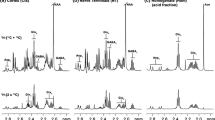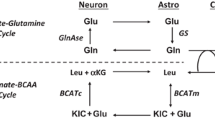Abstract
In order to provide evidence relevant to the hypothesis that nonsynaptically derived α-ketoglutarate serves as a metabolic precursor of the neurotransmitter pools of glutamate and GABA the uptake and metabolism of α-ketoglutarate by nerve terminal enriched material was studied and compared to corresponding data for glutamine. Both α-ketoglutarate and glutamine were transported across the cell membrane by high affinity and low affinity carriers. Under conditions prevailing in vivo α-ketoglutarate probably is transported primarily by its high affinity carrier, whereas gluatmine should be transported primarily by one or more low affinity carriers. Based upon reciprocal uptake inhibition experiments glutamine appeared to be transported by the alanine preferring system, and to a lesser extent by the basic amino acid and large neutral amino acid carriers. A comparison of the rate of uptake by different cellular preparations enriched in either nerve terminals or cell bodies indicated that α-ketoglutarate is transported selectively by nerve terminals. Both substrates were rapidly converted to glutamate; however, glutamine was more readily metabolized to GABA. The results of our study are consistent with the concept that both glutamine and α-ketoglutarate derived from extra-neuronal sources are taken up by nerve terminals and utilized to replenish the neurotransmitter pools of glutamate and GABA.
Similar content being viewed by others
References
Berl, S., andClarke, D. D. 1969. Metabolic compartmentation of glutamate in the CNS. Pages 168–197,in Lajtha, A., (ed.), Handbook of Neurochemistry, Vol. 1, Plenum Press, New York.
Van den Berg, C. J. 1970. Glutamate and glutamine. Pages 355–379,in Lajtha, A. (ed.), Handbook of Neurochemistry, Vol. 3, Plenum Press, New York.
Roberts, E. 1981. Strategies for identifying sources and sites of formation of GABA-precursor or transmitter glutamate in brain. Pages 91–102,in DiChiara, G. andGessa G. L. (eds.), Glutamate as a Neurotransmitter, Raven Press, New York.
Shank, R. P., andAprison, M. H. 1979. Biochemical aspects of the neurotransmitter function of glutamate. Pages 139–150,in Filer, L. J. Jr. et al. (eds.), Glutamic Acid: Advances in Biochemistry and Physiology, Raven Press, New York.
Shank, R. P. andAprison, M. A. 1977. Glutamine uptake and metabolism by the isolated toad brain: evidence pertaining to its proposed role as a transmitter precursor. J. Neurochem. 28:1189–1196.
Bradford, H. F., Ward, H. K. andThomas A. J. 1978. Glutamine as a substrate for nerve endings. J. Neurochem. 30:1453–1459.
Potashner S. J. 1978. The spontaneous and electrically evoked release from slices of guinea pig cerebral cortex of endogenous amino acids labelled via metabolism ofd-[U-14C]glucose. J. Neurochem. 31:177–186.
Hamberger, A. C., Chiang, G. H., Nylen E. S., Scheff, S. W., andCotman C. W. 1979. Glutamate as a CNS transmitter I. Evaluation of glucose and glutamine as prescursors for the synthesis of preferentially released glutamate. Brain Res. 168:513–530.
Gjessing, L. R., Gjesdahl, P., andSjaastad, O. 1972. The amino acids in human cerebrospinal fluid. J. Neurochem. 19:1807–1808.
Shank, R. P., andAprison, M. H. 1981. Present status and significance of the glutamine cycle in neural tissues. Life Sciences 28:837–842.
Maker, H. S., Clarke D. D., andLajtha, A. 1976. Intermediary metabolism of carbohydrates and amino acids. Pages 279–307.in Siegel G. J., Albers, R. W., Katzman, R., andAgranoff, G. W. (eds.), Basic Neurochemistry, Little, Brown and Co., Boston.
Hertz, L. 1979. Functional interactions between neurons and astrocytes I. Turnover and metabolism of putative amino acid transmitters. Prog. Neurobiol. 13:277–323.
Shank, R. P., Campbell, G. LeM., Freytag, S. O., andUtter, M. F. 1981. Evidence that pyruvate carboxylase is an astrocyte specific enzyme. Soc. Neurosci. Absts. 7, 936.
Campbell, G. LeM., Schachner, M., andSharrow S. O. 1977. Isolation of glial cellenriched and depleted populations from mouse cerebellum. Brain Research. 127:69–86.
Shank, R. P., andCampbell, G. LeM. J. Neuroscience (accepted).
Altman, J. 1972. Postnatal development of the cerebellar cortex in rat. J. Comp. Neurol. 145:353–397.
Shank, R. P., andCampbell, G. LeM. 1981. Avid Na+-dependent, high-affinity uptake of alpha-ketoglutarate by nerve terminal enriched material from mouse cerebellum. Life Sciences 28:843–850.
Juggi, J. S., Iyng Karan, N., andPrathap, K. 1979. Hyperammonemia in Reye's Syndrome. Pages 411–432,in Crocker, J. F. S. (ed.), Reye's Syndrome II, Grune and Stratton, New York.
Cheng, S. C., Nakamura, R., andWaelsch, H. 1967. Relative contribution of carbon dioxide fixation and acetyl-CoA pathways in two nervous tissues. Nature 216:928–929.
Wenthold, R. J., Harmison, G., Neises, G., Altschuler, R., andFex, J. 1981. Aspartate aminotransferase as a possible glutamate/aspartate marker. Am. Soc. Neurochem. Abstracts 12:256.
Chee, P. K., Dahl, J. L., andFahien, L. A. 1979. The purification and properties of rat brain glutamate dehydrogenase. J. Neurochem. 33:53–60.
Meister, A. 1979. Biochemistry of glutamate: glutamine and glutathione. Pages 69–84,in Filer, L. J., Jr., et al. (eds.), Glutamic Acid: Advances in Biochemistry and Physiology, Raven Press, New York.
Kvamme, E. andOlsen, B. E. 1981. Evidence of compartmentation of synaptosomal phosphate-activated glutaminase. J. Neurochem. 36:1916–1923.
Battistin, L., Piccoli, F., andLajtha, A. 1972. Heteroexchange of amino acids in incubated slices of brain. Archives Biochem. Biophys. 151:102–111.
Balcar, V. J., andJohnston, G. A. R. 1975. High affinity uptake ofl-glutamine in rat brain slices. J. Neurochem. 24:875–879.
Roberts, P. J., andKeen, P. 1974. High affinity uptake for glutamine in rat dorsal roots but not in nerve endings. Brain Res. 67:352–357.
Baldessarini, R. J., andYorke, C. 1974. Uptake and release of possible false transmitter amino acids by rat brain Tissue. J. Neurochem. 23:839–848.
Sershen, H., andLajtha, A. 1979. Inhibition pattern by analogs indicates the presence of ten or more transport systems for amino acids in brain cells. J. Neurochem. 32:719–726.
Lajtha, A., andSershen, H. 1975. Inhibition of amino acid uptake by the absence of Na+ in slices of brain. J. Neurochem. 24:667–672.
Morre, M. C., andWurtman, R. J. 1981. Characteristics of synaptosomal tyrosine uptake in various brain regions: effect on other amino acids. Life Sciences. 28:65–76.
Seiler, N., andDeckardt, K. 1976. Association of putrescine, spermidine, spermine and GABA with structural elements of brain cells. Neurochem. Res. 1:469–499.
Author information
Authors and Affiliations
Rights and permissions
About this article
Cite this article
Shank, R.P., Campbell, G.L. Glutamine and alpha-ketoglutarate uptake and metabolism by nerve terminal enriched material from mouse cerebellum. Neurochem Res 7, 601–616 (1982). https://doi.org/10.1007/BF00965126
Accepted:
Issue Date:
DOI: https://doi.org/10.1007/BF00965126




